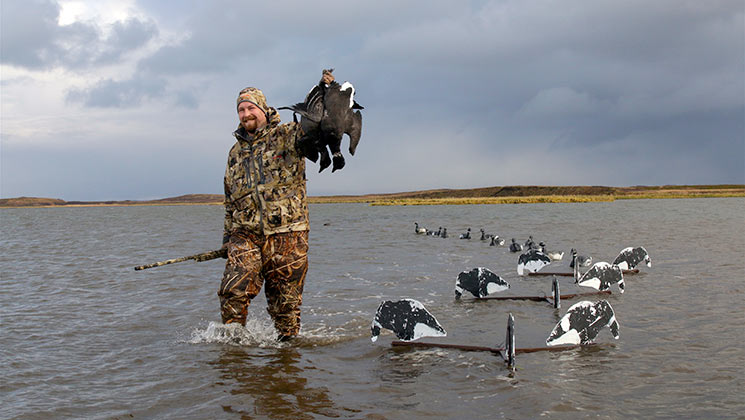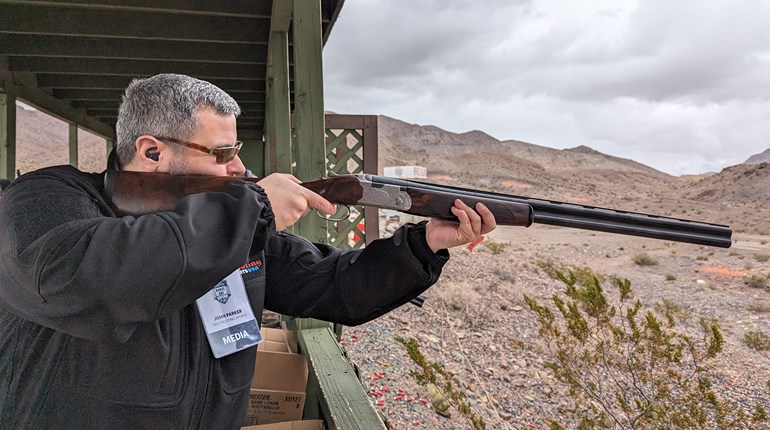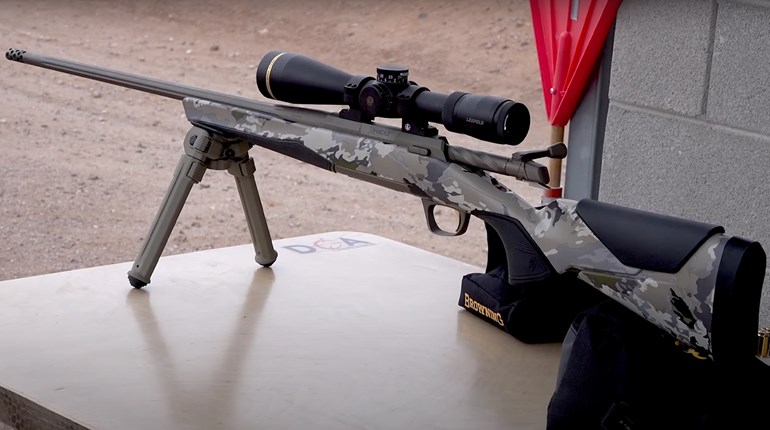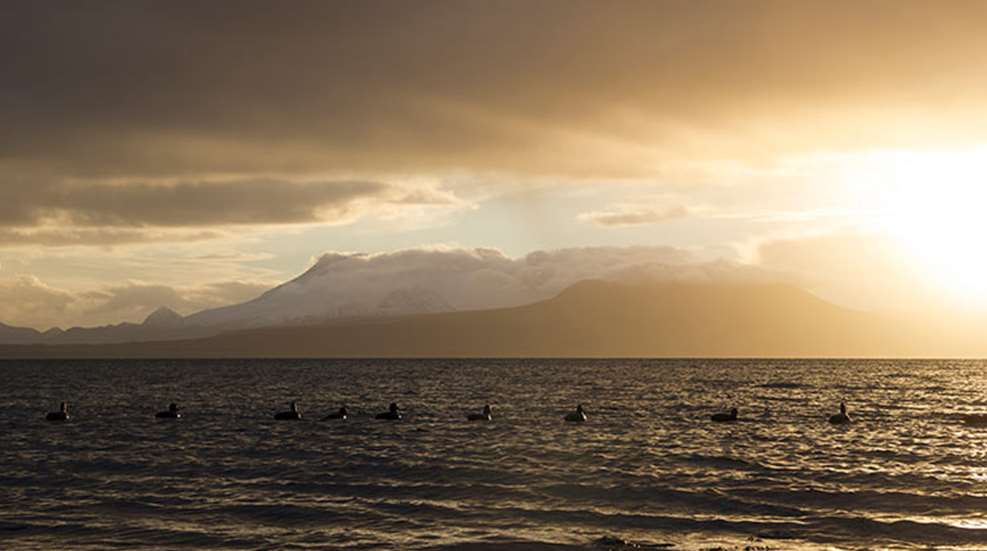
I suppose we didn’t have to venture out in it. One look out the window from the safety of the small lodge in Cold Bay would normally deter most sane folks, but hey, we were here, and we were waterfowl hunters, so “nasty” suited us.
Sending rain and ice into our eyes, the winds were filled with indignation, probably gathered as they blew over Russia on their way to this isolated strip of land. Keeping my head up just enough to follow the tracks of the person in front of me—and watch for bears—became an increasingly painful task. Lips turned to pincushions as each strike felt like it drew blood. Cheeks numb to the bite, we were only halfway to the bank of the inland lagoon in which myself and another hunter would spend the morning. The bank looked closer from the truck, and each strained step through the tangled, soggy, waist-high grasses provided little in the way of visible progress.
Making it to a walking trail helped immensely, until I looked down at the scraps of fish and scat piles the size of dinner plates that marked it and realized it wasn’t a trail made by humans at all. Seeing the first face-sized print in the mud told me a decision to keep my head down to avoid the rain would be a poor one. The single 00 buck shell that was passed out to everyone prior to leaving the truck now made sense, and yet it seemed grossly inadequate as my eyes and brain finally got together to unravel the meaning of the countless highly visible, and thus highly used, trails that sprawled out and crisscrossed the tundra as far as the eye could see. We were not supposed to be here.
“Saw a big sow with her cub last week,” proclaimed Capt. Jeff Wasley, “just beyond that rise. We usually see a few, but they keep their distance.”
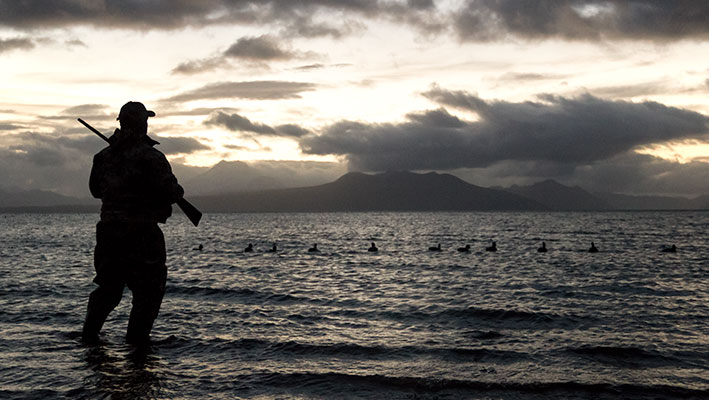
As much as I anticipated grizzly activity around every bend and over every hill—and gripped my shotgun accordingly—we made it to our destination, a small, isolated corner of the lake, without a glimpse of fur (which was ultimately depressing on some level, having never before seen a grizzly). Accepting that the rain wasn’t going to phase the new Benelli SBE 3 shotguns we were carrying, we tucked ourselves into the least waterlogged spot on the bank we could locate to sit out the storm. What few birds we saw, save for the single teal that dropped into the white-capped drink as we were tossing the last of the few decoys, were flying hard and high with the northwest wind.
There was no dog this morning, so we set the blocks close to shore, hoping the few weeds that were hanging on to the lake bed would also hang on to any downed birds long enough for us to wade out 20 feet and collect them. Despite the gray conditions, our spirits were as high as the rampart peaks that surrounded us, and when an unusual bird swung our way they got even higher. It was a drake Eurasian wigeon. Its rust-colored head was unmistakable against the cold, drab sky. We were warned we might see one or two, and this one was heading straight for our meager spread.
With Mother Nature’s gusts giving the odds to the duck, I pulled my lead way out front and fired as the bird buzzed low over the breaking waves. Overcompensating, the shot broke the water just in front, and the bird climbed. I followed it, adjusted for success and tried again. Nothing. My wall-hanger pulled up and away from my life for good. It was a scenario that wouldn’t be repeated, thankfully, but one I’m sure was initiated from on high to let me know this Alaska thing, well, wouldn’t be easy. I was living a true Alaska adventure, through and through—exactly what I was hoping for.
Owner and head guide of Four Flyways Outfitters Jeff Wasley at first glance is as salty as the surrounding waters. After one day of chasing birds, however, his salt became my favorite seasoning for this rare Alaska experience. Wasley, or “Cap” as he was called by the end of the week, above being a great guy, a hell of a boat captain and guide, and a more-than-apt shuffleboard player, is an expert on waterfowl. Sea-dwelling ducks and geese are his specialty, and Jeff had provided the details and updates on the migration patterns of the various species that coincided with our trip: Harlequins, Pacific black brant and Pacific eider—the pride of Cold Bay and the birds we’d be chasing, birds I’d presumably never get a shot at anywhere else.
His confidence told us he knew where to find them. Assuming the wind would allow us to float the icy waters of the Pacific, I was sure even at the start that Cap would do all he could to make it happen, even if Alaska had other ideas—and it did.
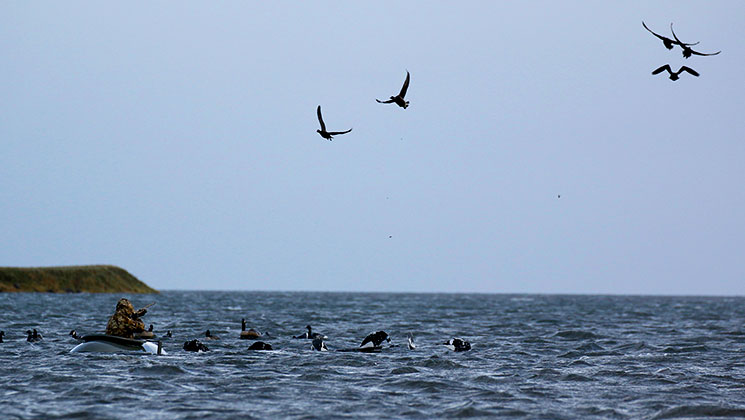
Our first excursion to the somewhat sheltered lake ended with little to show for it. A drake pintail did skirt the outside of the spread, and out of desperation I raised my gun. The bird pulled up like the space shuttle but before it reached orbit I sent a load of Hevi-Metal into its feathery body. The wind claimed it instantly and carried that duck 60 yards out before setting it down, too far for our two-legged retriever. It was the last bird we’d shoot that day. Despite being dry underneath our Sitka coats, the relentless barrage of cruelty from above eventually forced an admittedly premature retreat to the truck.
Back at the lodge, through spoonfuls of rejuvenating chicken soup, we spoke of more inclement weather forecast for the following day. The big Pacific, and its eiders, would once again have to wait.
Splitting into two groups the next morning, I, along with a fellow outdoor writer, followed the youngest guide, aptly named “Pup,” to the shores of Cold Bay. The rest of the hunters hopped a boat to the sheltered waters of Izembek Lagoon to take a crack at the black brant for which the area is known. The plan was to rejoin the group after an hour or so of hunting on the beach, hopefully with a weighted strap of slate-blue Harlequins over our shoulders. Of course, nothing yet in Alaska had worked out exactly as we planned.
Our short Harlequin hunt lasted a lot longer than anticipated. It wasn’t due to an unbelievable amount of birds, but rather a lack of them—that, and stubborn hunters. The particulars of our setup were a bit primitive. With no blind and a string of decoys stretched out less than 30 feet offshore, we were instructed to simply lie down on the rocky beach just beyond the surf and watch for incoming birds. It was like hunting from a layout blind, without the blind. If it wasn’t for the most incredible view I had ever seen in my life, I’d have thought we were wasting time. Watching the sun rise over the waters of Cold Bay and the surrounding mountains of the Aleutian Range, ancient volcanoes still smoldering with a dormant fury in the distance ... well, words do little justice. It’s safe to say either of us would have been willing to make this trip, with or without shotguns in hand.
But as luck would have it, a dark shadow hugged the shoreline and landed in the decoys. With confirmation from the guide that it wasn’t a protected Steller’s eider, a load of my No. 4 Hevi-Shot laid its head into the salty water. My first bucket-list bird was a beautiful drake Harlequin, steely blues with brown highlights and crisp, white bars painted by the masterful hand of Mother Nature. We should have had two more but they landed just outside the spread, and with a hen in the mix, neither of us would risk the shot. Aside from the lone seal that repeatedly popped its head above the waterline to inspect the decoys, and the red fox that scrounged the shores for a quick meal a few hundred yards away, our beach hunt was an otherwise lonely affair.
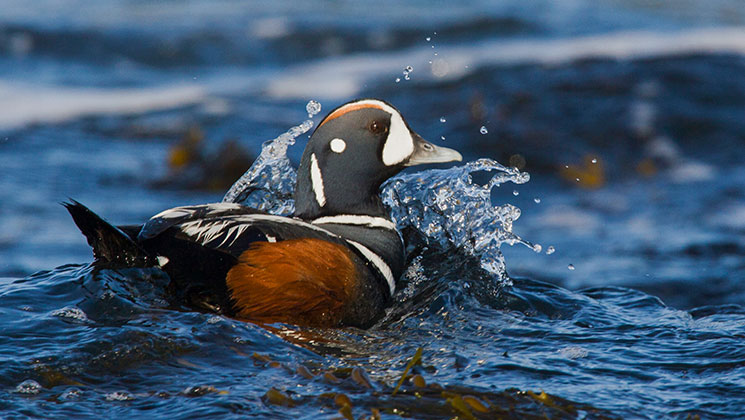
Rallying with the others at Izembek Lagoon later in the afternoon proved to be a more fruitful endeavor. Located in the heart of the 315,000-acre Izembek National Wildlife Refuge, the brackish waters of Izembek Lagoon are home to one of the largest and last beds of eelgrass in the world. With such a feast only inches below the water, the lagoon becomes a literal buffet for a multitude of migrating birds during the fall, including the entire world population of Pacific black brant. And with rafts of the dark geese lifting and dropping all around us, it was doubtful we’d have trouble filling the three-bird limit. In fact, by the time we arrived in late afternoon, the group had but one bird left to kill.
Bobbing from the low vantage of layout boats, and with strings of V-boards jutting out from our bows, the most difficult aspect of the hunt wasn’t locating the birds. The difficulty lay in picking out single, mature birds to kill. Black brant fly in bunches, and as they land those bunches become a balled fist seemingly ready to punch through the decoys. Picking out singles is difficult but not impossible, and Cap went over the methods for success. The trick is to wait until they are just about to dip their toes in the water before rising from your boat. You can shoulder your gun, but don’t fire yet. Instead, wait until the group sees you and panics. As they pull up to escape, the brant separate, providing shooters with an opportunity at single birds, breasts presented proudly for incoming steel. When it was finally my turn in the boat, a full-limit, three-bird strap came faster than I would have liked, in hindsight. It was day two of my Alaska adventure, and already my bucket was starting to fill up.
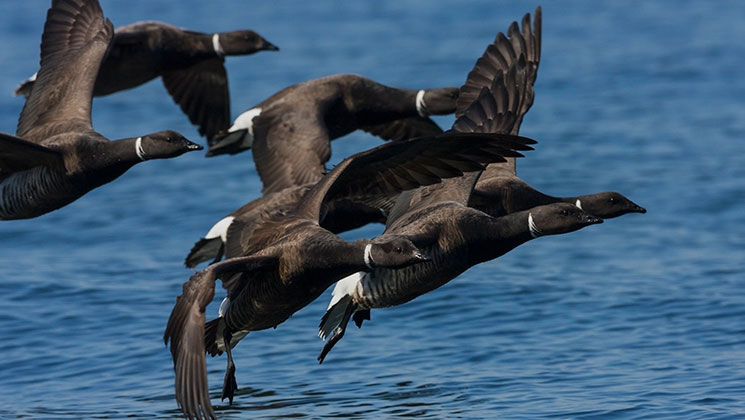
We woke on the third day in Cold Bay to hot coffee and a good weather forecast. Today was to be the day we’d go after the largest of North American ducks, the Pacific eider, in the now manageable waters of the Pacific Ocean. My turn, though, would come after a morning hike to a distant lake where teal of the green-winged and Eurasian variety were known to loaf. It would be a haul to get there, an anticipated 3 miles or so, all part of the allure to me and the three others that quickly volunteered for the adventure. Five minutes until go time, and the phone rang—Alaska threw us a curve ball.
Mark Vander Zanden (Cap’s senior guide) emerged from the door and shouted, “Change of plans, we gotta pull a stuck truck.”
Hearing such a statement, one’s mind can picture many things. Mine, of course, painted what I knew: spinning tires buried deep, flinging mud over a crew of hunters at the rear pushing with all they could muster. … If only that were the case.
The reality of the “stuck truck” in Cold Bay, Alaska, was much worse. Jaws dropped as we came around the last bend to the river crossing. Before us was a raging current about 50 yards wide, moving faster than you’d want to step into. Toward the far bank was the stuck Chevy Suburban, wheels beyond buried, icy Alaska water gushing over the hood, the still-attached boat and trailer bent sideways in the strong, mid-river current. The hunters that once filled the vehicle were on the far bank now, soaking wet among a pile of gear bags and shotguns. They’d just experienced a real Alaska emergency. And while the reality of the actual danger had yet to set in, I imagine it was a rush to say the least, as adrenaline-induced smiles still crested their faces.
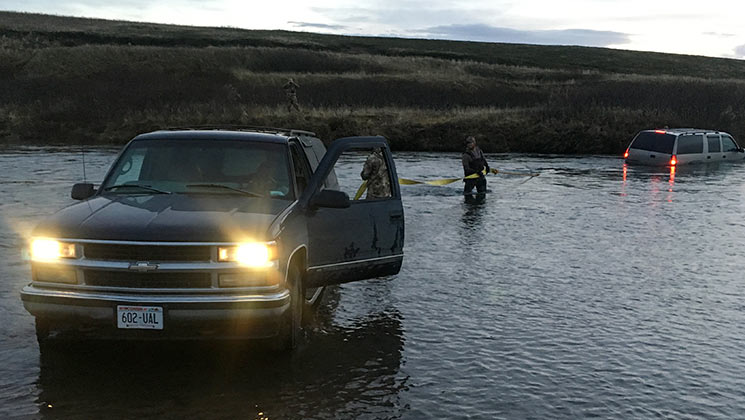
Working as quickly as we could, we unraveled two large tow ropes and backed our four-wheel-drive truck to the muddy river’s edge. The initial concern was the boat and trailer. Every second that passed allowed thousands of gallons of water to push on the buoyant craft, which due to its attachment to the Chevy, meant time was of the essence. The boat was cut loose and quickly floated downstream, coming to rest on the bank not far way. One obstacle cleared. With the weight of the boat removed, the trailer began to lift and twist in the current, threatening to flip the big Chevy on its side. Forming a human chain, the crew waded out, dragging the heavy tow ropes over our shoulders to avoid being dragged down ourselves. Eventually, and with deliberate footsteps, we made a connection between the sinking Chevy’s trailer and the 4x4, with one more truck daisy-chained at the lead for good measure. At the count of three we pulled.
The Chevy came out all right, and we dumped what seemed like an Olympic swimming pool’s worth of water out of the cab once the doors were opened. While it was a disaster, we avoided any real casualties, save for a camera or two and, of course, Cap’s ego. But he made up for it quickly. To the absolute astonishment of every eye there to witness, with only 10 minutes or so of dry time, Cap crossed his fingers and turned the key. It sounded like a drowning grizzly, but after spewing water like a fire hose from the exhaust pipe for a minute or two, the beast actually started up. It seems even the trucks are tougher in Alaska.
The trip to the distant lake happened, albeit a few hours later than it was supposed to. And while the hike through the tundra was incredible, the teal didn’t give us the show we were hoping for. Luckily, though, the scenery did. It was hard to be discouraged surrounded by that much beauty. With good friends and great laughs, it was one of the most pleasant afternoons I’ve ever spent lying in the sun.
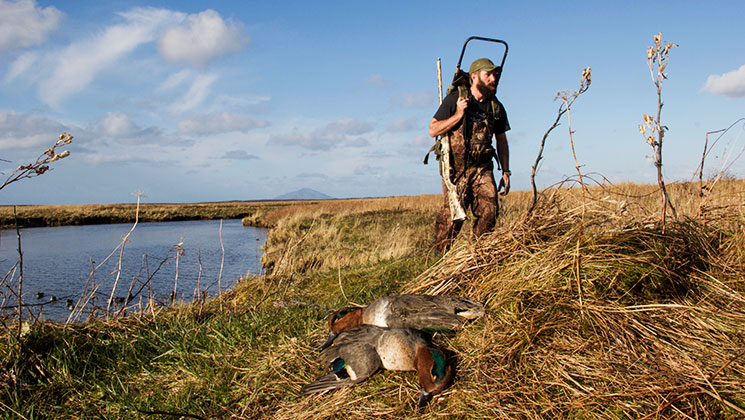
It’s amazing how things can so quickly change.
I was reflecting on that wonderful afternoon the next day while lying in the back of a small rubber dingy bobbing in the unnerving vastness of Cold Bay. With George Thompson from Benelli stationed in front of me, we looked like a two-man bobsled team that ended up way off track. The Alaska weather had returned, bringing more rain along with it. Thankful for the few ducks that were checking us out—oldsquaws and scoters—our shotguns had frequent chances to bark. Feeding the guns as fast as possible, the constant jostling of waves beneath us made already difficult shots darn near impossible.
Right about the time we were contemplating the sanity of our choice to brave the waves, a black scoter presented itself to George, and his shot hit home. Of course, I didn’t see it. No, I was too busy staring wide-eyed at the black water not 10 feet to the left of the dingy, where upon hearing the report from George’s Benelli, an unknown creature made a splash roughly twice the size of our meager little craft. George caught it out of the corner of his eye, too. I knew that because of the terror I saw on his face as he turned and asked, “What in the hell was that?” My response was neither helpful nor comforting. To this day, I can’t tell you what it was; perhaps a seal, a walrus, an orca, a blue whale for all I know. Regardless, the “creature from the Izembek Lagoon” that made that splash was large enough to swamp our tiny inflatable coffin. The look between us said it all; we’d made it out ahead thus far, and the big tender boat couldn’t get there quick enough.
Still, Alaska wasn’t done with us. Seems there was room for a few more blessings—and one more curse—before our trip would come to an end.
The weather finally turned, allowing us to hit the large expanse of Pacific Ocean where its namesake eiders loaf. On the wing, those magnificent birds are big; in hand they’re downright enormous. Though shots on the eiders didn’t come easy, with the big 17-foot deep-V and the Zodiak acting as tender boats swapping hunters from one dingy to another all afternoon, fine specimens of Harlequin, scoters and even Pacific eiders eventually found their way onto our duck straps.
We had pulled it off, our Alaska adventure. We’d be leaving with the birds we set out to take and fonder memories than most would ever acquire. Loading the boats for the journey back to the dock, none of us wanted it to end. She must have heard my whispered prayer, because Alaska soon obliged.
We spent the final evening watching the sun set over the Aleutians from the bank of a lonely shore while the Zodiak pulled the newly crippled deep-V a few more miles to the boat ramp. The motor had given out less than a mile into our return trip, and rather than tow an already overloaded boat with one not suited for the job, we chose to abandon ship and hold out for a new ride. Cap promised he’d be back for us, and we trusted he would. For the time being, though, we simply sat on that beach, content beyond description, burning the last of the mountainous scenery into our retinas. With a bounty of beautiful ducks set out on the rocks before us and the grandeur of Alaska’s Aleutian Range beyond, we all hoped he’d take his time.
